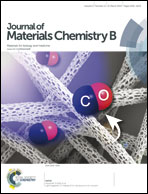Applications of porous organic frameworks (POFs) in detection of nucleic acid and exonuclease I activity†
Abstract
As a two-dimensional (2D) ordered porous organic framework (POF), PAF-6 is demonstrated to have an extraordinarily high fluorescence quenching ability to dye-labeled single-stranded DNA (ssDNA). Based on its different affinities to ssDNA and double-stranded DNA (dsDNA), and to ssDNAs with different lengths, PAF-6 is firstly utilized as a simple, cost-efficient, sensitive and selective sensing platform for sequence-specific detection of DNA and activity analysis of exonuclease I (Exo I). In these two systems, the sensing approach is accomplished by simply mixing the dye-labeled ssDNA probe with the targets and PAF-6. The targets of DNA and Exo I are specifically and sensitively detected with detection limits of 0.6 nM and 0.03 U mL−1 (S/N = 3), respectively, by using PAF-6 as a fluorescence quencher of the dye-labeled ssDNA probe. The results of this study suggest that PAF-6 can be developed as an excellent platform for the detection of nucleic acid and nuclease activity. In addition, PAF-6 exhibits a remarkable ability to protect ssDNA probe from enzymatic digestion, which may greatly extend the applications of the proposed ssDNA probe/PAF-6 sensing system to bioanalysis and biomedicine.


 Please wait while we load your content...
Please wait while we load your content...